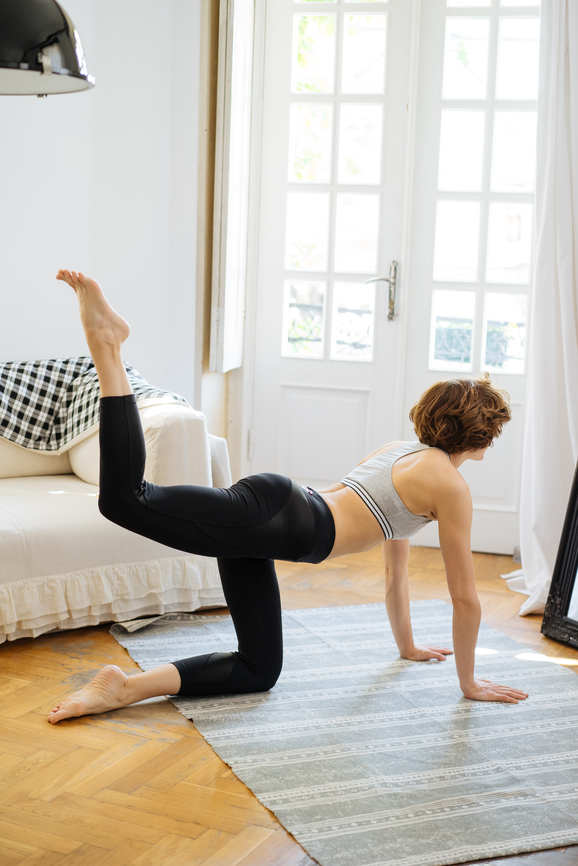
How Pelvic Floor Therapy Healed My Body After Birth
Of the many, many things I was not prepared for when I decided to have a child, the postpartum experience is at the top of the list. I’m not talking about the sleeplessness, breastfeeding struggles, being touched out, or general terror of suddenly having a helpless little person entirely in our care; I’m talking specifically about all the ways my body would be permanently altered. I’d read the books and gone to the classes and followed the Instagram accounts, but I still went into labor and delivery with only a vague idea of what I could expect my body to endure, let alone what recovery would be like. While we were carting our (totally healthy) newborn to the pediatrician every other day to monitor her weight that first week, I had to rely largely on the advice of friends and Dr. Google to both diagnose and care for the pain and discomfort I was feeling. I wasn’t even supposed to see my OB/GYN until six weeks postpartum, at which point the primary takeaway was that I was pronounced somehow “Cleared for sex!” (Reader, when I tell you I cackled at this news…!)
“It was, frankly, kind of shocking to go from having near-constant doctor’s appointments leading up to the Big Event only to be left to my own devices once it was over.”
It was, frankly, kind of shocking to go from having near-constant doctor’s appointments leading up to the Big Event only to be left to my own devices once it was over. I mean, pushing a human, however small, through the canal of a vagina must have some pretty significant impacts on the body, right? But the mainstream conversation about a postpartum mother’s body seemed primarily concerned with weight loss. After my birthing class called birth a “trauma” and told me that the event itself was the athletic equivalent of running a marathon, I couldn’t believe that the only kind of aftercare in our national discourse was about “How to get your pre-baby body back.” (Spoiler alert: your body is forever altered after having a baby. And that’s totally fine.)
So whether you’re thinking about having a baby and wondering about what can happen “down there” afterward, or if you’re simply interested in learning more about how to generally support your body as you age, let’s get into it — starting with the pelvic floor.
What Is the Pelvic Floor?
I had a vaginal delivery, which meant that for about three hours, I was pushing a baby the size of a spaghetti squash through my vagina, absolutely wrecking the area known as the pelvic floor. My what? Yeah, I hadn’t heard about it at that point, either.
“The pelvic floor serves many key functions, like being the supportive base for the uterus, bladder, and bowels.”
“The pelvic floor is a collective term for the [three layers of] muscles, ligaments, nerves, connective tissue and bones that serve as the collective ‘basket’ area of the body,” says Dr. Jaclyn Tolentino, DO, Senior Doctor at Parsley Health. It serves many key functions, like being the supportive base for the uterus, bladder, and bowels. It contains the sphincter mechanics in charge of elimination and incontinence prevention, and is crucial to body stabilization by supporting the pelvis and hips. The pelvic floor also takes part in the detoxification through lymphatic structures of the groin area along the internal and external iliac arteries. So, it’s like, kind of a big deal.
And yet, like so many American women, my pregnancy, birth, and postpartum experiences, which made up almost a year of near-constant doctors’ appointments, included Z-E-R-O mention of this part of my anatomy.
How Do Birth And Pregnancy Affect The Pelvic Floor?
While it seems obvious to me now that thinking about my pelvic floor should have been top of mind when I got pregnant, I was getting bombarded instead by pregnancy weight loss influencers, or advertisements for creams that would prevent stretch marks. And all the while, long-lasting changes were already taking place in my pelvic floor.
“During pregnancy, the pelvic floor muscles continue to stretch and expand to accompany the growing baby, and during childbirth, these muscles are stretched to their maximal potential.”
– Dr. Jaclyn Tolentino, DO, Senior Doctor at Parsley Health
“During pregnancy, the pelvic floor muscles continue to stretch and expand to accompany the growing baby, and during childbirth, these muscles are stretched to their maximal potential,” says Dr. Tolentino. “Unfortunately the pelvic nerves may also be compromised during this process, which might affect their function, as well as the function of the pelvic floor.”
About a year after giving birth, I noticed that if I sneezed or laughed particularly hard I um, peed a little bit. You might wonder why it took me so long to notice this, and that’s because being pregnant makes you tolerant of this sort of thing: My body had undergone such an incredible amount of change in order to accommodate the growth, delivery, and then the feeding of my daughter, that things like peeing myself a little bit sometimes just didn’t raise any kind of alarm anymore. But when I finally did Google it and learn the term “prolapse,” I was surprised to learn how common it was: When I say “common,” I mean 50% of women who have had children experience some kind of prolapse. But guess what? Only 10-20% seek medical attention for it.
According to Dr. Tolentino, symptoms of pelvic floor dysfunction vary widely, and can include:
- Vaginal symptoms such as: pain in the vagina, bulging, heaviness, or swelling in the area, pain during sex, vaginal prolapse, sensitivity when wiping, itching, burning, or a raw feeling in the area.
- Urinary symptoms such as: the urge to urinate frequently or inflammatory pain during urination, incomplete bladder emptying, incontinence (leakage) related to coughing, laughing, or sneezing, or bladder prolapse.
- Problems with bowel movements, such as: pain or straining with bowel movements, frequent constipation, loose or uncontrollable stools, uncontrollable/loose flatulence (gas), incomplete bowel movements, rectal prolapse, bleeding with defecation, or even rectal burning-like pain or redness around the anus.
“While childbirth and pregnancy are common triggers for pelvic floor dysfunction, they aren’t the only contributors.”
And while childbirth and pregnancy are common triggers for pelvic floor dysfunction, they aren’t the only contributors. “Falling on your tailbone or hip areas, chronic infections, hormonal dysfunction, gynecologic issues such as fibroids or endometriosis, surgeries, or nerve damage to the pelvic area,” says Dr. Tolentino, can all cause problems to the pelvic floor, too.
Once I realized that peeing myself a little bit was not something I just had to live with, I decided to seek out medical attention, aka pelvic floor physical therapy.
My Experience in Pelvic Floor Physical Therapy
I was surprised to have to really press my OB/GYN into providing a referral for me to start physical therapy. For some reason, pelvic floor physical therapy is still relatively new in America, unlike in France, where the government famously subsidizes treatments for its postpartum citizens. I didn’t really know what to expect from pelvic floor physical therapy — surely it wouldn’t just be someone counting off Kegel exercises for me, right?
“Pelvic floor therapists support all areas of pelvic floor health, with special attention on strengthening your entire pelvic floor,” says Dr. Tolentino. I saw a wonderful provider who helped treat my immediate issue and educated me so that I could continue to support and care for my pelvic floor in the long term. I went to three sessions, though some people might go for fewer or more, depending on the issue and the severity of the symptoms.
Here’s the basic rundown of my experience:
Session One
I filled out a lengthy questionnaire and then had a long, private conversation with my provider. She then performed an external physical exam that included an assessment of my spine (I had to touch my toes at the beginning), muscles, and joints. I did a few lunges, and walked back and forth, and we discussed what she was observing. Then, she did an internal assessment that was not unlike a pelvic exam for my annual OB/GYN appointment, minus the Pap smear: She inserted a gloved finger into my vagina, where she palpated the walls. She also had me contract and relax the muscles on cue, holding the contraction at times, so she could assess the strength of my muscles (okay, so we did do some Kegels).
Session Two
“I was surprised how many of the exercises are familiar toning and weight exercises, like lunges and squats.”
This is when the technology came in. We started with some Kegels and manual therapy, where she used her gloved fingers again to palpate the vaginal canal and hold on “trigger points,” or areas where I felt some discomfort. This helps to relax the muscles and prepare for biofeedback. This part was fascinating: using a sensor probe inserted into my vagina, we were able to measure the strength of my contractions. I am kind of a data geek, and I really loved getting to see these numbers on the screen. We used a few different tools that were honestly kind of a blur – I did some contractions when instructed, we got some numbers, and I went on my way. Nothing hurt, though it was a little weird at moments to have what looked like various sex toys presented for physical therapy.
Session Three
We repeated many of the manual and biofeedback exercises. My numbers were very positive, so we agreed that I could continue working on the exercises at home. My provider then gave me a list of exercises I could continue, with or without the tools. Since my issue was relatively mild, I didn’t end up needing to try other therapies, which can include dry needling, electrical stimulation, and even laser therapy.
I was surprised how many of the exercises are familiar toning and weight exercises, like lunges and squats. My provider even suggested practicing Pilates regularly as one excellent way to continue our work at home, since a strong core only helps to support the area.
Pelvic Floor Health: Before and After Pregnancy
According to both my pelvic floor physical therapist and Dr. Tolentino, it’s never too early to engage in exercises to strengthen your pelvic floor. “Prior to pregnancy is actually the best time to start as your body prepares for what’s to come this proactive step can help strengthen your pelvic floor muscles, especially if they were weak prior to pregnancy,” says Dr. Tolentino.
“Prior to pregnancy is actually the best time to start as your body prepares for what’s to come this proactive step can help strengthen your pelvic floor muscles, especially if they were weak prior to pregnancy.”
– Dr. Jaclyn Tolentino, DO, Senior Doctor at Parsley Health
Dr. Tolentino suggests the following general recommendations for everyone (not just related to pregnancy!) looking to care for their pelvic floor health:
- Do a self assessment: Have you been experiencing any symptoms that could be related to your pelvic floor? Maybe it’s just pain or sensitivity in your genital/rectal area, or maybe you’ve been having issues with bowel movements? Maybe it’s just general back pain. We might not necessarily associate these symptoms with pelvic floor dysfunction, but that may be what they’re pointing to.
- Keep a bladder diary if you’re concerned that you are urinating too frequently, avoiding frequent trips to the bathroom when you don’t feel the “urge” to urinate. You want to train or re-train your bladder to empty when (and only when) you feel the urge.
- Pay attention to your posture and body mechanics, even when you are sitting on the toilet. For those that work on the computer, prioritize optimal ergonomics to avoid any upper back and neck straining. If your back doesn’t feel supported and straight in alignment, this can cause dysfunction in your lower back and hip areas. When you are sitting on the toilet, avoid excess pushing or straining; this creates a large amount of downward pressure on the pelvic floor.
- Avoid sitting for extended periods of time, as this creates a lot of pressure on your spine, back, and hip areas. Stand, stretch, or take a short walk after more than 30 minutes of sitting.
- Avoid tight clothing for extended periods of time, and even thong underwear as this can be irritating to the vaginal area. Choose cotton underwear when you can as it is the most breathable, and consider sleeping commando (Yes!).
- Consider the effects of frequent physical activity that can cause trauma or increased pressure to the pelvic floor, such as biking, or spinning, or even swimming in a tight bathing suit.
For additional support with your pelvic floor, seek the support of your care team and consider seeing a pelvic floor therapist who can assist in guiding you to optimal pelvic floor health.
Stephanie H. Fallon is a writer originally from Houston, Texas. She has an MFA from the Jackson Center of Creative Writing at Hollins University. She lives with her family in the Blue Ridge Mountains of Virginia, where she writes about motherhood, artmaking, and work culture. You can find her on Instagram or learn more on her website.




